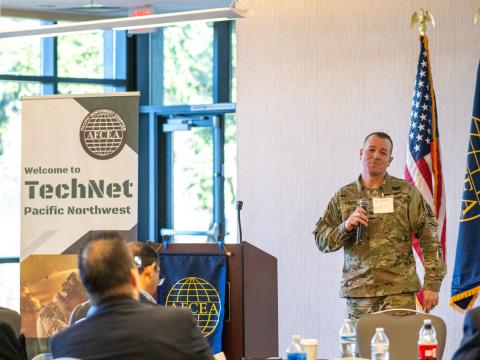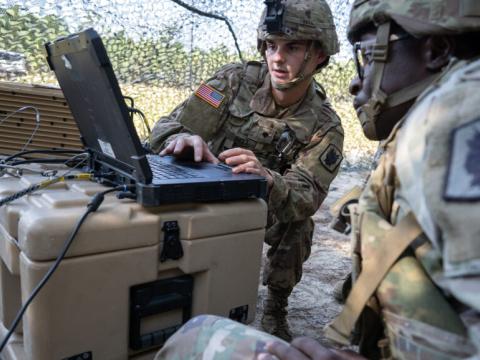Military Forges Components of Future Mobile Communications Platform
Program targets voice, data compression methods to increase tactical battlefield systems’ bandwidth capacity.
The U.S. Army is assessing a prototype multimedia network that will serve as a technology testbed for prospective military tactical wireless systems. Part of a joint program of the Army’s Communications–Electronics Command, Fort Monmouth, New Jersey, and industry, the two-year project involves studying the best ways to apply civilian off-the-shelf hardware and software to tactical battlefield uses. Potential benefits include new types of mobile devices with minimal requirements for cables or additional attachments—greatly decreasing the amount of equipment transported or carried by Army personnel.
The constant need for fresh data is driving the Army to increase the scalability of its communications systems. As more data is made available to warfighters in the field, additional robust mobile systems are required to provide information services. Tactical radios now can transmit data and graphic images to front-line commanders. In the near future, as systems such as Land Warrior enter service, bandwidth requirements will continue to increase as will the need for a means to prioritize different types of battlefield messages.
The voice telephony over asynchronous transfer mode (ATM) program is a collaborative effort of the Army; SRI International, Menlo Park, California; and Cisco Systems Incorporated, San Jose, California. The goal of this partnership is to develop more efficient multimedia services across a tactical network. According to William Sverapa, director of the Communications–Electronics Command’s (CECOM’s) warfighter information network (WIN), the program is exploring the next generation of integrated voice, video and data services to the warfighter with the ultimate goal of replacing the Army’s current mobile subscriber equipment.
In this dual use science and technology (DUST) program, the government can partner with industry and leverage commercial sector technology to meet its tactical needs. According to Sverapa, one of the biggest challenges the Army faces in the tactical communications arena is lack of bandwidth. Collaborative approaches such as these allow the service to look at different solutions that provide the highest quality transmissions over limited data pipes, he adds.
The ultimate goal of this and other DUST programs is to develop technologies that mesh into the future combat system (FCS), Sverapa says. The voice telephony over ATM project and others serve as mechanisms to insert technologies into the FCS concept and ultimately reduce the warfighter’s equipment load.
Ongoing science and technology objectives serve as feeders, funneling new systems into the FCS concept. One initiative is called the multifunctional, on-the-move, secure, adaptive, integrated communications (MOSAIC) advanced technology demonstration, aimed at researching mobile systems. As new methods are introduced, older components can be replaced. Simply removing the private branch exchange (PBX) from the network reduces the amount of wiring that must be installed by 50 percent, Sverapa says. Analog or possibly Internet protocol (IP) telephones would replace the PBX. Sverapa notes that the results of the voice over ATM program will be fed into MOSAIC for implementation.
These technologies would allow the Army to reduce the amount of communications-related equipment it needs, Sverapa observes. If this program performs as expected and the IP-based telephone system works properly, then the PBX segment of the architecture can be removed entirely, which will save money, he adds. Nancy Vail, a senior research engineer at SRI, explains that these savings come through the use of conventional equipment and standards-based software. These create an opportunity for interoperability and eliminate the need to purchase proprietary equipment in bulk, she says.
The network for the voice over ATM program is fixed to a wire-based system. Consequently it is not mobile. However, Sverapa emphasizes that the overall program goal is to develop wireless mobile communications for the Army. To this end, the technology and techniques developed in this DUST project will go through a series of phases, transitioning to the MOSAIC effort and beyond. “What we’re trying to do is demonstrate the concept that we can implement this type of technology. Once we demonstrate that it is feasible, then we go on to the more difficult pieces of doing wireless and on-the-move,” he explains.
Called the integrated video, data and voice laboratory, the testbed consists of a three-node network located at Fort Leavenworth, Kansas; Fort Monmouth, New Jersey; and SRI’s Menlo Park offices. The command battle laboratory at Fort Leavenworth hosts the network’s hub. The Internet service provider is Qwest Communications International, Denver, Colorado.
The project uses a public ATM network instead of a private one. This demonstrates that without changing commercial standards, the system can still be used to implement quality of service (QOS)-type concepts—a key goal for future tactical operations, says Robert Grillo, an SRI research engineer.
Once the network was operational, one of the partnership’s primary duties was to determine the interoperability of the testbed located at Fort Monmouth. Tests have been conducted with two kinds of communications—videoconferencing standard H.320 type and integrated service digital network. According to Vail, recent work has focused on H.323 protocols over an ATM backbone. Engineers are emphasizing interoperability issues—what the system may encounter—and identifying viable solutions based on available standards-based equipment. “Basically, we’re looking at commercial off-the-shelf equipment. We are conducting standards-based interoperability testing using standards-based software and equipment but implementing it in a way that’s supportive of the military’s needs,” she says.
Cisco Systems provided much of the hardware used in the voice over ATM program. These include routers such as Cisco’s 3810 multimedia concentrator, which serves as a focal point for the network. The router has an ATM interface to a T-1 circuit. A Polycom Incorporated videoconferencing system feeds into this, as does a trunk line from a Lucent Technologies PBX. These are all funneled into the ATM link, Grillo says. He envisions replacing the PBX because the Cisco router can handle telephone routing.
The network features IP telephones, which eliminate the need for a separate voice network. According to Edward MacKenzie, a systems engineering manager for Cisco’s federal group, these devices can be either a virtual telephone, which is a personal computer with a telephone application, or a telephone connected directly into an Ethernet switch. They also have wireless capability, he adds. The IP feature allows voice messages to be prioritized on a network either through universal messaging, which allows voice mail to appear automatically on a user’s computer, or via facsimile, greatly simplifying the process of sending orders to warfighters, he relates.
At the halfway point of its two-year project, the program’s primary achievement has been establishing connectivity to the testbed and working with the ATM provider, Grillo says. Each application uses a different quality of service over the ATM network. For this purpose, three different types of circuits have been set up: multimedia videoconferencing, voice communications and data traffic.
The biggest success to date has been showing that there are three commercially compatible ways to get into the system, Grillo notes. Accessibility comes through the network’s multimedia hub—a Polycom videoconferencing system connected to a PC over conventional commercial telephone lines or via the Internet. He notes that the network ATM system was recently switched from permanent virtual circuits to switched virtual circuits that can release bandwidth when they are not in use—a key feature for a limited tactical system, he observes.
Getting around the bandwidth limitations inherent in tactical communications is another major thrust of the program. One SRI contribution to the project is research into compressing voice traffic. Sverapa notes that a number of compression techniques exist, but they all operate on different bandwidths. The goal of the researchers at Menlo Park is to enhance those protocols to make voice calls more efficient and less bandwidth intensive.
SRI is investigating a process called controlled degradation in quality, John McPherson, an SRI systems engineer explains. “If you have problems or limitations with bandwidth, by carefully selecting which packets you drop to accommodate the degradation of bandwidth, you can have a controlled degradation in the voice quality that’s still usable but is running over a lower bandwidth pipe,” he says.
According to Vail, one application of this technique is for voice calls. The goal is to determine the number of packets that can be dropped while maintaining voice quality and allowing more calls on the same amount of bandwidth. Likewise, ways to maintain voice calls if the bandwidth is reduced are also being explored, she says. While data and video traffic are increasingly important, she thinks voice is still the prime factor in military communications systems. “We still believe that voice calls are the most important. Video is great for communication, but obviously the minimum is voice,” she points out.
SRI also is looking at a traffic management method in which a command center or node would first be referenced to determine whether to accept a call. The goal is to have call acceptance based on voice quality. If the quality is not good enough for a valid voice call, it would not go through, Vail adds.
By using QOS technology, requests for communications can be prioritized, MacKenzie allows. He notes that one of the problems with dedicating virtual circuits to voice, video or data is that they cannot be used for other applications. QOS provides IP precedence, which allows a particular application or user to be tagged. For example, if a general or a colonel is online or wishes to make a telephone call, the system could be set to give such persons a higher priority than the average private who picks up the telephone, MacKenzie says. Precedence levels can be set for particular types of traffic or even a specific type of user so that, on average, they would receive better quality transmissions than others using the network.
Through programs like DUST, the Army is already beginning to lay the foundation for a future voice and wireless network, MacKenzie shares. He notes that all of the routers being used by the WIN-T group at Fort Monmouth are voice enabled. These routers have gateway and security functions built into them. The DUST program also is testing wireless cards. A mini-hub using this technology can connect wireless devices in a 125-foot radius through concrete walls. Installing narrowband long-distance antennas could also serve to connect node centers. “You could walk around anywhere in a tactical operations center with a laptop or a handheld computer of some sort and be completely Internet accessible,” he says.
MacKenzie predicts that within the next decade, bandwidth will become so plentiful that the majority of communications and data applications will be wireless; however, bandwidth will continue to be an issue in the tactical realm for some time. “They are going to come out with new radios that will improve things, but they will always be limited because the more bandwidth we give people, the more they’re going to use,” MacKenzie maintains. As bandwidth increases, new applications will appear that use up large chunks of it, which will continue to make it an issue in tactical battlefield environments; however, bandwidth will be plentiful for wide area applications, he adds.
Wireless applications such as wireless hubs will increase connectivity and save money associated with wiring entire buildings with fiber optic cable. For example, the buildings at West Point are national landmarks, which precludes drilling holes in the walls for cable. Wireless hubs could inexpensively connect the entire campus, he offers.
Mobile applications are important and critical to battlefield personnel, MacKenzie points out. Currently under the DUST and WIN-T programs, when vehicles of a tactical operations center set up communications, they must back up to each other and connect all of their equipment with cables. If they were fully wireless, they would only have to be within a certain radius to be connected, he says.




Comments